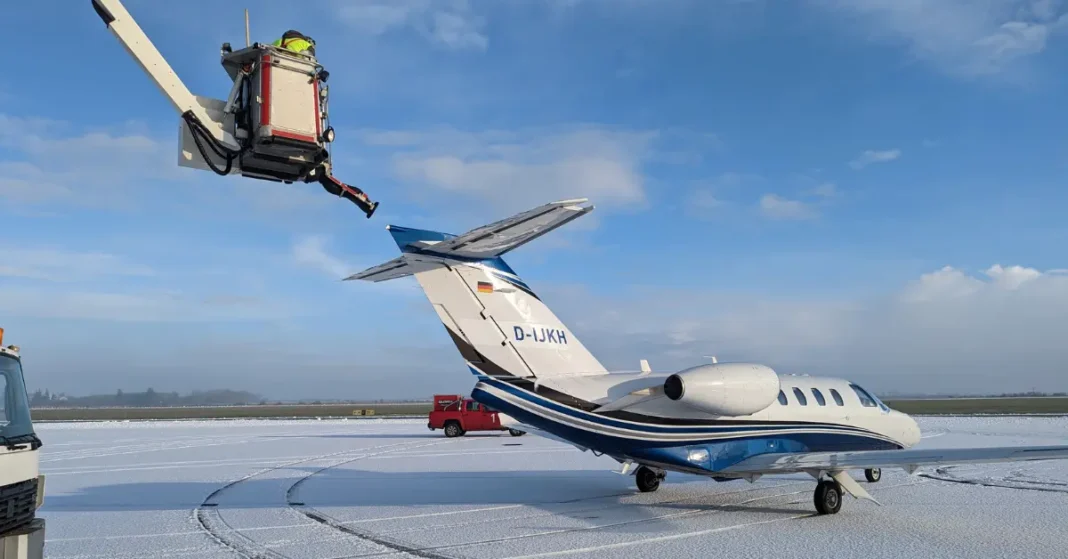Flying in snowy weather adds an interesting dimension to aviation—a mix of weather conditions, how planes work, and the determination of people to overcome challenges.
This article looks into how snow affects how planes perform, considering things like how engines work, how well pilots can see, and how the weight of the plane is balanced for efficient operation.
We’ll talk about both the numbers and the quality of how snow can impact planes, covering everything from how engines run to how well pilots can see and how efficiently the plane works. The situations become more critical with different types and amounts of snow, emphasizing the need for effective solutions in these tough, real-world conditions.
Table of Contents
The Impact of Snow on Aircraft Performance
The impact of snow on the performance and function of an aircraft is multifaceted. Extensive testing, research, and accumulated data reveal that snow imposes several challenges on flight operations. While aircraft are built to withstand a broad scope of weather conditions, snow is unique in its ability to disrupt flight operations, from takeoff and landing to affecting the physical structure of the aircraft.
Cold weather scenarios, especially when coupled with snow accumulation, impact aircraft’s functioning by freezing or blocking the key components that enable flight.
For instance, the build-up of ice or compacted snow on the wings of an aircraft can disrupt the smooth flow of air over the wing surface, reducing lift and making takeoff more difficult.
Moreover, the accumulation of snow on the aircraft can add substantial weight and alter the balance of the aircraft, requiring adjustments in load balancing and fuel consumption.
Another significant aspect is the impact of snow on runways which may drastically reduce the friction between the aircraft tires and the runway surface, making landing, and takeoff more perilous.
To combat these issues, ongoing research and technological advancements are dedicated to enhancing aircraft’s resistance to snow and cold-related challenges. This includes developing anti-icing systems and improving procedures for snow removal from runways and aircraft surfaces.
However, it is crucial to contain these challenges in understanding the impact of snow on the functionality and performance of aircraft, as aviation safety hinges upon these dynamics.
Mitigation Measures for Snow During Flight
Indeed, scientific advancements have been instrumental in helping aircraft mitigate the impacts of snow. One area of remarkable progress is within deicing technologies.
Aeronautical engineers have developed innovative deicing systems that employ thermal energy to combat the accumulation of ice on an aircraft’s wings and fuselage. This technique, known as a thermal anticoagulant system (TAS), circulates heated, aircraft-engine-induced air throughout the wing and tail surfaces to melt collected snow, thus mitigating the risks associated with undue weight and imbalanced aircraft handling.
The introduction of hydrophobic coatings as a potent strategy against snow-related problems warrants acknowledgment as well. These superhydrophobic, or water-repelling, coatings have been designed to reduce the adhesion of ice to the aircraft’s surface.
Moreover, these innovative films are not only instrumental in repelling snow and ice but also in enhancing the streamlining of air over the plane’s body, thus enabling the craft to preserve its aerodynamic stability and efficiency.
High-resolution weather prediction systems are another asset that aviation technology has leveraged for dealing with snow. Accurate and prompt forecasting of weather conditions can significantly aid in proactive preparation and adjustment of flight schedules, thereby preserving both safety and efficiency.
Multifaceted weather radars equipped on board can continuously monitor atmospheric conditions in real-time during a flight, enabling pilots to avoid areas of heavy snowfall, turbulence, and icing conditions.
Conclusively, the relentless pursuit of scientific refinement and technological ingenuity has effectively reduced the vulnerability of aircraft to snow, thereby bolstering the safety and convenience of aerial travel in snow-prone regions.
The methods developed to counteract the formidable complexities snow brings to aviation demonstrate how advanced technological solutions can ensure safety and efficiency in flight. Detailed are the pre-flight procedures and in-flight technologies—from deicing and anti-icing measures to heated leading edges and advanced radar systems—that stand as the industry’s vanguard against the pitfalls of winter weather.
These sophisticated strategies are further aided by developments in weather prediction tools that enable the continuation of flight operations even amid heavy snowfall. Despite potential drawbacks and limitations, these measures underscore humanity’s resilience and ingenuity in maintaining the crucial role of aviation in the face of nature’s most challenging weather conditions.
Do planes fly when snowing?
Airplanes can operate in light snow conditions due to de-icing and anti-icing measures. However, substantial snowfall may result in flight delays, cancellations, or even airport closures, contingent on the specific aircraft, airport equipment, and pilot training in use.
Will my flight be Cancelled due to snow?
Aircraft can operate in light snow, but significant snowfall may lead to flight delays, cancellations, or even airport closures. The decision to fly is influenced by factors such as the intensity of snow, airport equipment, pilot training, and the type of aircraft in use.
How cold is too cold for airplanes?
Planes can endure frigid temperatures, including cruising at -57°C. However, safety considerations are crucial due to factors like jet fuel freezing around -40°C, mitigated by additives. Cold temperatures can affect fluids, and materials, and lead to ice formation, necessitating thorough pre-flight assessments. Airlines prioritize safety, ensuring confidence in safe flying by considering specific conditions and aircraft capabilities.





